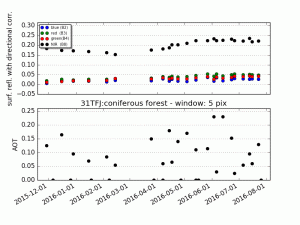Some news from Theia’s production of Sentinel-2A L2A data
![]() =>
=>![]() The production of Level2A Sentinel-2A data by Theia is a little delayed, but we will still deliver, before the end of the month, the level 2A products acquired over France by Sentinel-2A so far. The production of the other selected sites, and the real time production will start a little later. It is not a piece of cake to start our new processing center (MUSCATE), which will require a significant part of CNES computing facilities. We need to put together in working order the L2A processor, MACCS, the ground segment, MUSCATE, which prepares the data, decides the sequences of processing and allocates the ressources, and CNES computing center : « the Cluster ». The operational production of Sentinel-2 L2A data (processing of all the sites acquired since beginning 2016 and real time processing of all newly acquired data) is being delayed because the integration of MUSCATE in the Cluster meets issues of disk access performances which were not observed in the test configuration
The production of Level2A Sentinel-2A data by Theia is a little delayed, but we will still deliver, before the end of the month, the level 2A products acquired over France by Sentinel-2A so far. The production of the other selected sites, and the real time production will start a little later. It is not a piece of cake to start our new processing center (MUSCATE), which will require a significant part of CNES computing facilities. We need to put together in working order the L2A processor, MACCS, the ground segment, MUSCATE, which prepares the data, decides the sequences of processing and allocates the ressources, and CNES computing center : « the Cluster ». The operational production of Sentinel-2 L2A data (processing of all the sites acquired since beginning 2016 and real time processing of all newly acquired data) is being delayed because the integration of MUSCATE in the Cluster meets issues of disk access performances which were not observed in the test configuration
Meanwhile, Theia will soon release the data we produced over France on the test configuration. I already used this data set in this blog post, and obtained the joined figure. To release the data, we still have to transfer the data on the distribution server, which has also a few glithces to repair. This should be ready by the end of the month. And finally, the test processing allowed us to find a little bug. When more than 256 clouds are found in the image, our processor finds shadows anywhere. Such images are not that frequent, and we had not identified this bug with the first images we processed. However,the overall data quality is good, and you’ll be able to use it to make first tests. Of course, we will update the data with our new, corrected processor. We are very sorry for these delays which certainly must bother some of you, who have been waiting for this data set. CNES and the associated industrial teams are working hard to solve these issues and start processing as soon as possible.








